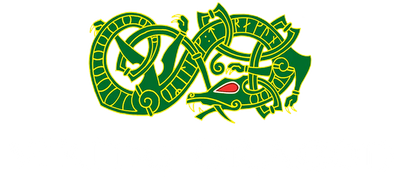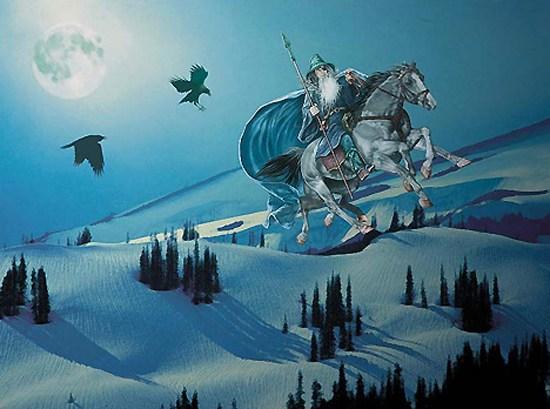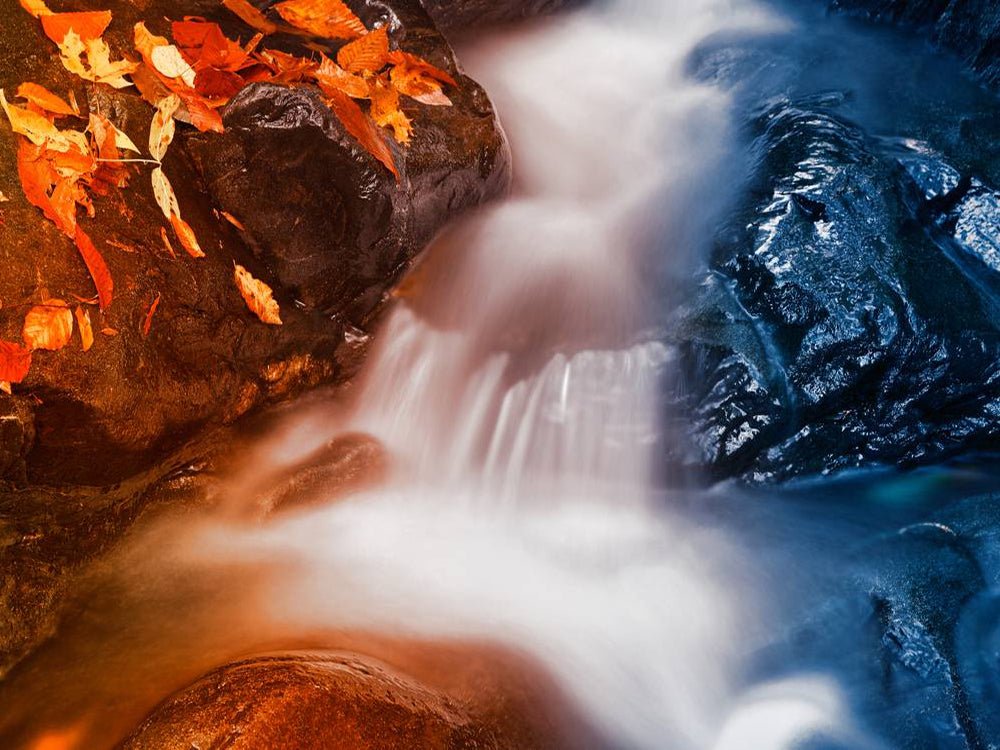In Scandinavia they don't call it Christmas (Christ-Mass), instead they still retain the old pagan name for the Yuletide celebrations which they call Jul (pronounced Yule).
Yule is a pagan festival that followed the midwinter solstice (usually around 21st December) and celebrates the return of the sun as the days slowly started to get longer again. The festivities, which involve lots of drinking and consuming of slaughtered animals, lasts up to 12 days, hence the 12 days of Christmas.
In Scandinavia it is still traditional to leave food out (usually porridge with butter) for the little red-capped Tomte or Nisse (household spirits or house elves) and thus we have the tradition of leaving food (usually cookies) out for Father Christmas, who in Sweden is called the Jul Tomte (the Yule Elf).

Another tradition in Scandinavia is that of the Christmas goat, whose origins are lost in the mists of time. The Jul Bok (Yule goat) is nowadays usually made from straw, which indicates that it was probably once an offering from the last harvest (like the British corn dollies), but other traditions have a man dressing up as goat at Yuletide, which could be distant memory of a pagan fertility ritual, or even be connected to the two goats who pulled Thor's chariot in Norse mythology.
Yule is the turning of the year when, as the days slowly start to get longer, the Nordic peoples celebrated the end of the year and the return of the sun, the completion of the another yearly cycle of life, death and rebirth.

The winter solstice was a particularly inauspicious the night when Odin was said to ride through the skies with the Wild Hunt collecting the souls of the dead. So everyone stayed indoors feasting, afraid to go outside lest they be caught out alone and abducted by the Wild Hunt.

The Modern English word Yule comes down to us via the Middle English yol from the Anglo-Saxon Geol, though nowadays it is more commonly known as Christmastide or the 12 Days of Christmas. However in Scandinavia they still call it jul (pronounced yule) or jol. One of the many names of Odin recorded in the Icelandic sources is Jolnir, which means The Yule One. Though this name probably refers to his role as leader of the Wild Hunt at Yule, rather than to a jolly giver of gifts! (I can find no evidence for the claim on Wikipedia that Odin was known as Jolfaðr, the Yule Father).

So how did Yule become Christmas? King Hakon of Norway, who was a Christian, passed a law that the Christian Christmas Day and the Pagan Yuletide celebrations were to be henceforth celebrated at the same time. While this only impacted the Norwegian territories it illustrates how these festivals were intentionally combined into one celebration.
We do know that the celebration of Yule wasn’t always twelve days long. The Norse text 'Heimskringla: The Saga of Hakon the Good' talks about it lasting for three days, or as long as the ale continued. The night it began was known as slaughter night, where animals would be ritually slain and their blood collected in bowls to be splattered over the wooden idols of the gods and over the participants using a bunch of twigs. The animals' meat was then consumed in a feast which was known at the julblot.
Other sources tell of the burning of a Yule log, the ashen remains of which were used to ward off evil spirits and other misfortunes, before being ignited again the following year to start the subsequent Yule fire. Also there was the eating of a Yule boar in honour of Freyr, a god associated with the harvest and fertility, who in Christian times became associated with St Stephen and his feast day of 26th December.
More variations can be found in 'Gulathingslog 7', where Yule was celebrated ‘for a fertile and peaceful season,’ we also see in the 'Saga of Hakon the Good' that Odin was hailed at this time as the bringer of victory, while Njord and Freyr were hailed for peace and fertility. Grimm’s Teutonic Mythology speaks of how Frau Holle’s annual wagon toured the countryside during the Yuletide season for blessings of a fruitful year ahead. Deities associated with winters, like the winter hunters Ullr and Skadhi, were also sometimes hailed. Since this is the day of darkest night, Nott (Goddess of Night), as well as silver-gleaming Mani (God of the Moon), may be honored. Some will also honor Dagr (God of Day) and Sunna (Goddess of the Sun) as she will only grow in prominence in the months ahead.
Odin, in his aspect as the God of Death and Transition, is almost always honored at this time. The Wild Hunt rages over the whole world seeking out and sweeping up the dead, ushering out the dead old year itself. It's also common to honor Freyr and an envisioned new year of growth and promise. Also, Thor is honored for driving back the Frost Giants.
It was customary that no work was to be done during Yuletide. From Germanic sources we see stories of the Goddess Berchta visiting peoples houses and punishing those who had been spinning during Yule. In the Icelandic 'Svarfdæla Saga', we see a warrior who postpones a fight until after the Yuletide, and 'The Saga of Hakon the Good' also says that Yule was to be kept holy.
Modern Heathens opt to celebrate this time as the Twelve Days of Yule, with the last day culminating on 12th Night. Ancient calendars followed a different method of time, the solstice celebrations, as well as later Christmas observances, can vary from place to place as to when they occur. Today, most Pagans and Heathens celebrate the Yuletide as running from approximately December 20 – December 31.
Some Heathen groups opt to conduct no business matters during the time of Yule. Some practitioners of the Northern Tradition will even choose to completely withdraw and go secluded from online mailing lists, bulletin boards, and social media outlets like Facebook so they can stay focused on spending the Yuletide with friends and family. While it’s not always an option for everyone, there are those who choose to use vacation time from work so they can have the entire Yuletide off as well.
Yuletide was perhaps the greatest of all Heathen holidays. It was a time of celebration and close family contact that lasted twelve days and nights; each of which can be viewed as a month of the preceding year in miniature. Many of the customs associated with Christmas may have begun from Heathen Yule rites and customs. Many Gods and Goddesses are honored during Yuletide, and most followers of Asatru believe that the gods, as well as the spirits of the earth and the ancestors, join us for the celebrations at this time of year.
Many traditions and practices are traditional to the month of Yule the most well known is, of course, the 12 Days of Yule. Some Heathens may bookend Yule with Mother’s Night and Twelfth Night and not have specific observances in-between those days, and some other Heathens have taken things a step further. Pulling inspiration from the Nine Noble Virtues, and combining it with candle-lighting celebrations like Chanukah or Kwanzaa, they have come up with a reason to light a candle every night during the Yuletide.
The alter on Yule should face north, the area is decorated with holly and mistletoe and dried leaves and fruit such as hips and haw. A chalice of appropriate wine, mead or cider. The oak or pine log with up to 13 green, white and red candles decorated with carvings, runes or symbols is placed centrally on the altar. The appropriate fragranced incense burning and scenting the air, e.g., bay, juniper, cedar, pine or rosemary is pretty good for this.
There are several versions and variations to the 12 days of Yule. I like to call it the Twelve Nights of Yule since I usually hold the honor at night and it is the darkest time of the year. The version below is a combination with the most common points. Each night starts with the main focus followed by a reading and closed with a virtue meditation. Alternatively, a month is offered each night as a reflection.

~The first night of Yule - Mother Night (Módraniht)
Sacred to Frigg, Freya, and the Disir
Industriousness
Yulmonath
~Second night of Yule - The Wild Hunt
Sacred to Odin and Ancestors
Perseverance
Horning
~Third night of Yule
Sacred to Mani and Darkness
Courage
Lenting
~Fourth night of Yule
Sacred to Aegir, Njord, and Freyr
Love
Ostara
~Fifth night of Yule
Sacred to Community
Hospitality
Merrymoon
~Sixth night of Yule
Sacred to Eir and Healing
Discipline
Midyear
~Seventh night of Yule
Sacred to Thor and Children
Fidelity
Haymoon
~Eighth night of Yule
Sacred to Skadi and Ullr
Truth
Harvest
~Ninth night of Yule
Sacred to Odin and Fathers
Honor
Shedding
~Tenth night of Yule
Sacred to Sunna and Light
Justice
Hunting
~Eleventh night of Yule
Sacred to the Valkyries and Warriors
Self Reliance
Fogmoon
~Twelfth night of Yule - Wassail
Sacred to all Divine Friends and Oath Night
Wisdom
Snowmoon
Glad Yuletide to Everyone. Hail!
-Sam Silver
Sources:
https://nordicwiccan.blogspot.com/2014/12/12-days-of-yule.html
https://www.scribd.com/document/229050352/12-Days-of-Yule
http://www.heathenhof.com/12-devotional-days-of-yule/
https://tressabelle.wordpress.com/2013/12/15/the-12-nights-of-yule/
Teutonic Mythology, Volume 4 By Jacob Grimm
Christmas Days: 12 Stories and 12 Feasts for 12 Days By Jeanette Winterson
The Old Magic of Christmas: Yuletide Traditions for the Darkest Days of the Year By Linda Raedisch.




